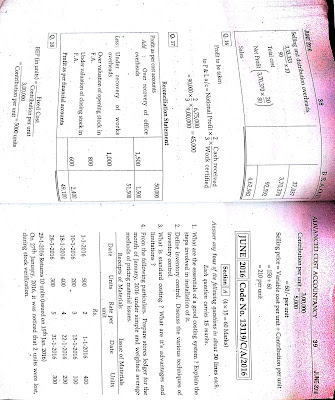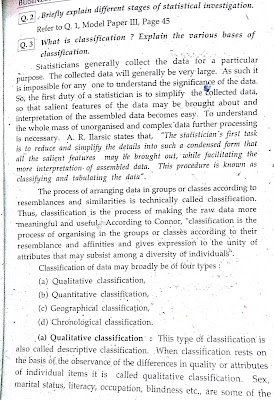Study B.Com General Important Notes as per BRAOU(Ambedkar Open University) Syllabus
Saturday, 22 September 2018
Monday, 16 April 2018
Investment s
Retired people or people having no regular sources of earnings with an investable lump sum amount can earn regular income in different ways. In India most popular instruments that can generate a regular income or can help someone withdraw money at regular intervals are:
1.Post Office MIS (Monthly Income Scheme)
2.Fixed Deposit
3.Senior citizen saving scheme
4.Monthly Income Plan of mutual funds (MIP)
5.SWP from mutual funds (Systematic Withdrawal plan)
6.Dividend from Mutual funds
7.Dividend from Equity
8.Annuity from Insurance companies
9.Rent from Real Estate
10.Long term Government Bond
People who mainly depend on fixed deposits or post office monthly income schemes for regular income often don’t realize that their money is losing value due to inflation. Their deposits continue to give out a fixed amount although their monthly requirement gradually goes up due to inflation. However, in the last three years monthly incomes have come down as much by 25 per cent as the interest rates have come down from 8.5 % to 6.5%. Those in the highest tax bracket feel the pinch the most as post-tax returns from deposits have come down to nearly 5 per cent. Keeping all this in mind, some of the alternatives that can be considered are monthly income plans (MIPs) and systematic withdrawal plan (SWP) in a debt mutual fund.
Monthly Income Plans (MIPs)
The Monthly Income Plan option for a regular income involves investing in Debt Mutual Funds with a monthly divided option. Most of these funds are conservative in their investment approach and allocate only 10-20% of their corpus into equities and the rest 80-90% in safer bonds and other debt instruments. The returns are not spectacular as compared to equity funds because of lower risk, but are enough to beat inflation. The attractiveness of MIPs is the relative safety they offer as these funds give investors good returns if stock markets do well, but they also protect the downside because of the limited exposure to equities.
From the taxation point also, MIPs are better than fixed deposits as the interest from fixed deposits is fully taxable. The post-tax returns from a fixed deposit that offers 8% are actually 5.6% for a person in the 30% tax bracket and this income is taxed every year even though he may get it only after the deposit matures. Also, if it exceeds a certain limit, it attracts TDS. So, there is no escape. On the other hand, gains from MIP funds are taxed only when the investor redeems the investment. Even then, only the gains are taxed and that too at a lower rate.
Investors should, however, be aware that though these plans are called “monthly income plans”, there is no assurance of monthly income. In fact, the dividend option of these funds is a very tax inefficient way to get a monthly income. Though the dividend received is tax-free, it comes to you after a heavy 28.84 per cent (25 per cent tax + 12 per cent surcharge + 3 per cent cess) dividend distribution tax on debt fund and 10% on equity funds. It is better to go for the growth option of the MIP fund and redeem units as and when you need the money.
You can also start a systematic withdrawal plan (SWP) under which a fixed sum is redeemed every month and put into your bank account.
MIPs can be good source schemes for systematic transfer plans (STP) into equity funds. In an STP, a fixed sum flows out of the scheme to another scheme (usually an equity fund) on a predetermined day of the month or quarter.
Be wary of the charges though. MIPs have high charges (some charge up to 2.5%), which can be a drag on the overall returns.
Systematic Withdrawal Plan (SWP)
Another better alternative to bank FDs is a systematic withdrawal plan (SWP) in a debt mutual fund. If you have invested in equity or debt mutual funds you can generate regular monthly income from mutual funds by selecting SWP (systematic withdrawal plan). SWP is a good option for those looking for income at fixed intervals, as SWP is a facility which allows investors to withdraw a specific amount of money from a mutual fund at regular intervals.
Most commonly, two options are available for SWP’s. In the first option, a fixed amount is withdrawn at a fixed intervals that could be monthly, quarterly, yearly etc. and in the second option, the appreciated amount is withdrawn on a fixed interval.
SWP in a debt mutual fund is tax effective than a bank fixed deposit. Although the dividend received in the hands of the investor is tax free, all non-equity investments attract DDT of 28.84%. The DDT is paid by the AMCs but eventually the investor has to pay. In a SWP, each withdrawal within 3 years from the date of purchase will be treated as a short-term capital gain. The gains will be added to the investor’s income and taxed accordingly. Withdrawal beyond 3 years from the date of purchase will attract long-term capital gains tax of 20%. But since the investor will enjoy indexation benefits, it is likely that investor is going to pay a lower amount in tax based on the indexed cost.
Which option is better for you and why?
Monthly cash flow requirements and tax efficiency are two most important factors that determine whether you should opt for dividend or the SWP option or MIP option. To summarize, for fixed monthly income, MIP and SWPs are two options. Under both these options investments are made in debt mutual funds. In the Monthly Income Plan the monthly income, however, is inconsistent as it depends on market conditions. Also in comparison to SWP’s, MIP’s are less tax efficient. Therefore, if one opts for a regular income investment plan, a systematic withdrawal plan is a superior alternative.
Monday, 26 February 2018
Income tax Updates 2018
Contrary to expectations, the Budget 2018 failed to do much for taxpayers as well as the salaried class. However, some sections of society, particularly senior citizens, gained much from its proposals. Whatever be the case, as a taxpayer we need to be aware of the tax proposals of this year's Union Budget as they are going to impact our earnings as well as the day-to-day lives from the upcoming financial year (2018-2019). Here we are taking a look at 10 such tax rules which will change from April 1, 2018:
1. Health and Education Cess
The Budget 2018 didn't make any changes in the tax rates or tax slabs for individuals and HUFs, which continue to remain the same for Assessment Year 2019-20 as applicable for AY2018-19. However, it has proposed a new cess – Health and Education Cess – which will be levied at the rate of 4% of income tax, including surcharge, in place of the current 3% Education, Secondary and Higher Education Cess from Financial Year 2018-19 onwards.
2. Reintroduction of standard deduction
At present no standard deduction is available for salaried employees. However, exemption in respect of transport allowance and reimbursement of medical expenses is provided. The Budget 2018 has proposed a standard deduction of a maximum of Rs 40,000. However, the current exemption in respect of transport allowance and reimbursement of medical expenses will be withdrawn. The net benefit will only be Rs 5,800.
3. Deduction in respect of interest earned by senior citizen
Currently, a deduction up to Rs 10,000 is allowed to all individuals in respect of interest income from deposit accounts (not being time deposits) held with any bank, co-operative society and post office.
It is proposed to allow a deduction up to Rs 50,000 in respect of interest income from deposits held with banks, co-operative society and post office by senior citizens. No separate deduction will be available under section 80TTA for interest income from savings account for senior citizens.
4. Medical treatment of senior citizens for specified diseases (Sec 80DDB)
Under the existing provisions, deduction is available to resident individuals and Hindu Undivided Family (HUF) for any amount incurred for the medical treatment of specified diseases (i.e. malignant cancers, AIDS, etc). The deduction is limited to Rs 60,000 for expenses relating to senior citizens and Rs 80,000 with respect to very senior citizens. The Budget has proposed to enhance the above deduction limit to Rs 100,000 uniformly for both categories.
5. Enhanced deduction for health insurance, medical expenditure related to senior citizens (Section 80D)
Under the existing provisions, a maximum deduction of Rs 30,000 is allowed to an individual or HUF for payment towards health insurance premium including Rs 5,000 towards preventive health check-up for resident senior citizens. Alternatively, very senior citizens can claim a deduction of Rs 30,000 for payment towards medical expenses where there is no insurance. The Budget 2018 has proposed a maximum deduction of up to Rs 50,000. Besides senior citizens can also claim the deduction for medical expenditure.
6. Compensation on termination or modification of employment
Currently, certain compensation in connection with employment is out of the purview of taxation, leading to base erosion and revenue loss.
"It is proposed that any compensation or other payments due to or received by any person in connection with the termination or the modification of the terms and conditions of any contract relating to his employment shall be taxable under the head income from other sources," according to a Deloitte report.
-
Benefits of GST | Advantages of Goods and Services Tax Updated on May 26, 2017 - 03:23:54 PM The Goods & Service Tax or GST ...






























